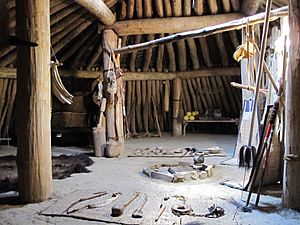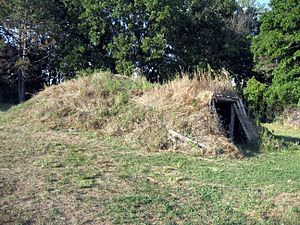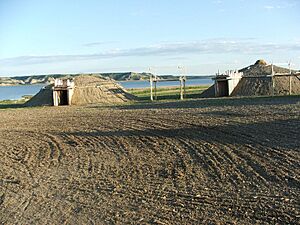Earth lodge facts for kids

An earth lodge is a special kind of building that is partly underground. It is covered with earth, either completely or just a bit. These homes are most famous from Native American groups who lived in the Great Plains and Eastern Woodlands areas.
Most earth lodges are round. They have a dome-shaped roof. Often, there's a hole at the top of the roof for smoke to escape. Tribes like the Hidatsa, Mandan, and Arikara used earth lodges. These tribes usually stayed in one place. Archaeologists have also found earth lodges from the Mississippian culture in the eastern United States.
Contents
How Earth Lodges Were Built
Building Materials and Methods

Earth lodges were usually built using a method called wattle and daub. This means they used a frame of woven sticks (wattle) and then covered it with a mix of mud, clay, and straw (daub). A thick layer of earth was put over this.
To make the dome shape, builders used tree trunks. These trunks were angled or carefully bent. Sometimes, they used hipped roofs too. Workers would dig down a few feet. This made the floor of the lodge lower than the ground outside. They put strong posts into holes around the edges of the lodge. The tops of these posts met in the middle.
This way of building was very strong. It allowed for large buildings, some as wide as 60 feet (18 meters). More than one family could live in these big lodges. The size was limited by how long the tree trunks were. Sometimes, extra posts were put inside to help hold up the roof.
After the main frame, a layer of sticks or reeds was woven over the roof timbers. Then, people often added a layer of thatch (like straw or reeds). The whole building was then covered with earth. This earth layer, along with being partly underground, helped keep the lodge warm in winter and cool in summer. It was like natural insulation.
The structures had an outer layer of clay. Underneath that was an inner layer of long grasses and a woven willow ceiling. The middle of the earth lodge was used for a fire pit. The smoke hole at the top was sometimes covered with a bullboat (a small, round boat) when the weather was bad.
People gathered logs each spring when the ice melted. They also cut fresh logs. The most common wood was cottonwood. Cottonwood is a soft, wet wood. Because of this, earth lodges often needed to be rebuilt every six to eight years.
Who Built Them and How They Were Used
In Hidatsa culture, men only helped with the very large logs. The women did most of the other work. Because of this, an earth lodge was considered to be owned by the woman who built it.
The entrance to an earth lodge often had a small hallway made of exposed logs. These entryways were usually 6 to 9 feet (1.8 to 2.7 meters) long. Inside the lodge, a windbreak was built. This blocked the wind and gave privacy to the people living there. Earth lodges also often had storage pits. These were like root cellars, lined with willow and grasses. Dried vegetables were stored in them.
Where to See Earth Lodges Today
Earth lodges were often built near tribal farm fields. People would use them for living. They also used tipis when they went hunting.
You can see a rebuilt earth lodge in Glenwood, Iowa at Lake Park. There's also a whole village of earth lodges in New Town, North Dakota. This village has six family-sized earth lodges and one very large ceremonial lodge. There's also a garden and corrals to make it look like it did long ago. This park is open to visitors.
The family earth lodges are about 40 feet (12 meters) wide. The ceremonial earth lodge is more than 90 feet (27 meters) wide. It's the biggest building of its kind in the world. This park is part of an effort by the three tribes of the Fort Berthold Indian Reservation to rebuild and share their culture. This is the first village of its kind built by the Mandan, Hidatsa, and Arikara Nations in over 100 years.
Earth Lodges and the Mississippian Culture
Some major sites of the Mississippian culture also had earth lodges. These were sometimes built before large mounds were created. Or, they were built on top of mounds. It seems that building, collapsing, and rebuilding earth lodges was part of how some mounds were made. This happened at places like Town Creek Indian Mound and some mounds at the Ocmulgee National Monument.
In Kanabec County, Minnesota, the Groundhouse River flows through an area where earth lodges were found. According to a book called The Aborigines of Minnesota, the river got its name from the earth lodges of the Hidatsa people. The Hidatsa lived there before the Sioux drove them west to the Missouri River. The Hidatsa lived in wooden huts covered with earth.
Images for kids




